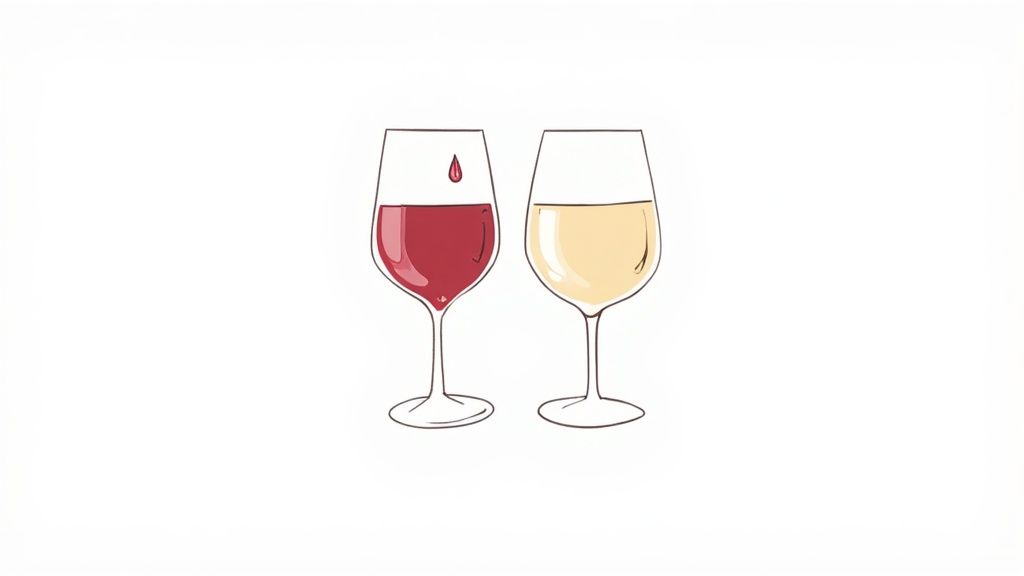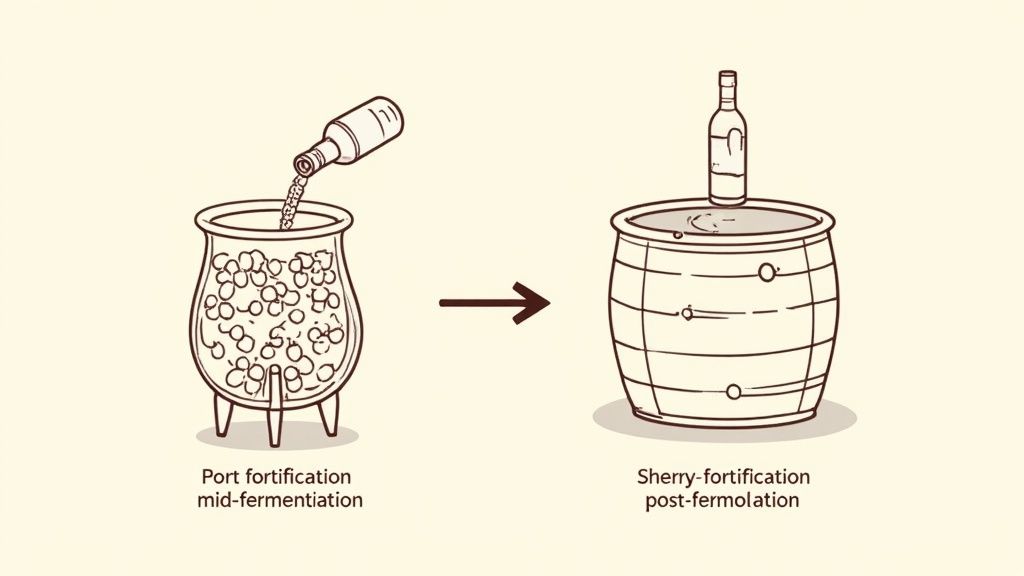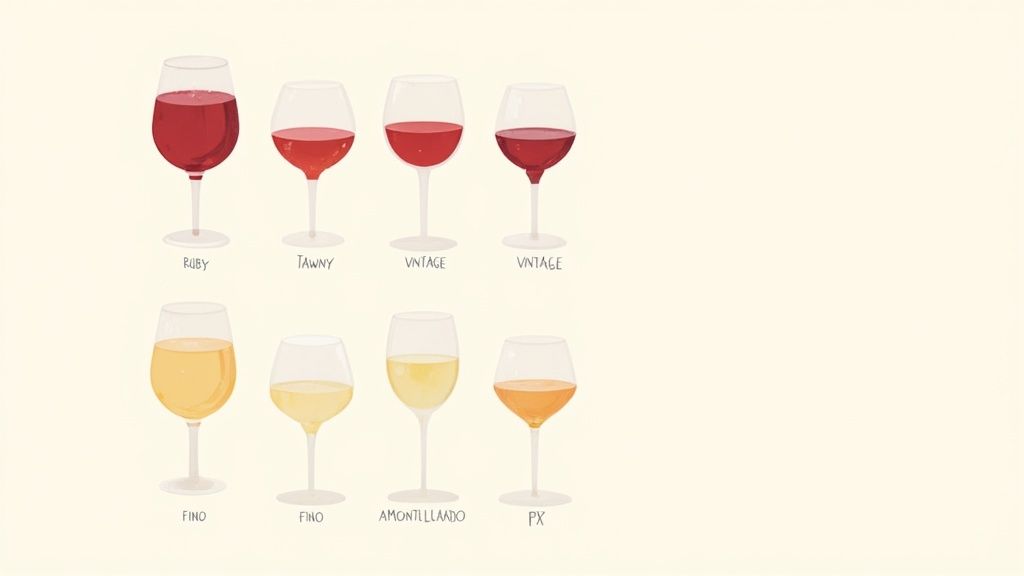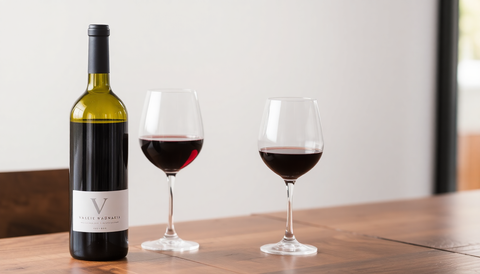At its heart, the difference between Port and Sherry is beautifully simple. Port is typically a sweet red wine from Portugal, while Sherry is usually a dry white wine from Spain.
The magic happens in when they’re fortified. Port gets its sweetness because the fortifying spirit is added during fermentation, which stops the yeast in its tracks and leaves plenty of natural grape sugar behind. Sherry, on the other hand, is fortified after fermentation is completely finished, resulting in a bone-dry base wine.
So, are you after something rich, sweet, and fruity, or an aperitif that’s crisp, nutty, and often savoury? That's the real question.
Understanding the Core Differences

While both are titans of the fortified wine world, their identities are shaped by completely different homelands, grapes, and winemaking philosophies.
Port’s defining sweetness is no accident. By adding grape spirit mid-fermentation, winemakers in Portugal’s Douro Valley intentionally preserve the lush, natural sugars of the grapes.
Conversely, Sherry producers in Spain let the fermentation run its full course, converting every last bit of sugar into alcohol. The fortifying spirit is only added at the end. For Sherry styles that are sweet, that sweetness is almost always added back in later. This single fork in the road is what sends these two wines on such wildly different flavour journeys.
To make things clearer, here’s a quick rundown of the key distinctions.
Key Differences Port vs Sherry at a Glance
| Attribute | Port | Sherry |
|---|---|---|
| Country of Origin | Portugal (Douro Valley) | Spain (Jerez Region) |
| Primary Grape Type | Red Grapes (e.g., Touriga Nacional) | White Grapes (Palomino, Pedro Ximénez) |
| Base Flavour Profile | Typically Sweet | Typically Dry |
| Fortification Point | During Fermentation | After Fermentation |
| Typical Colour | Red/Tawny | Pale Yellow to Deep Brown |
This table gives you the basics, but as we’ll explore, there’s a whole world of nuance and style within both Port and Sherry that makes them so fascinating to discover.
Exploring the Origins and Terroir

You can't separate a wine from its homeland. The most fundamental difference between Port and Sherry starts right there, with their legally protected origins. These aren't just names on a bottle; they're a guarantee that the wine in your glass is a true expression of a very specific place.
Port wine can only come from one place on earth: the ruggedly beautiful Douro Valley in northern Portugal. It’s one of the world's oldest demarcated wine regions, officially established way back in 1756. The landscape is defined by dramatic, steep-sided hills where vineyards are carved into terraces of schist and granite.
The hot, dry summers put the native red grapes, like Touriga Nacional, under serious stress. This forces them to produce fruit with an incredible concentration of flavour and a robust character. It’s this powerful fruit that forms the essential starting point for Port’s rich, full-bodied profile.
The Sherry Triangle
Sherry’s story, on the other hand, unfolds in the sun-drenched landscape of southern Spain. For a wine to be called Sherry, it must be produced within a small, legally defined area known as the "Sherry Triangle," formed by the towns of Jerez de la Frontera, Sanlúcar de Barrameda, and El Puerto de Santa María.
The defining feature here is the unique albariza soil. It’s a chalky, limestone-rich earth so bright it’s almost blindingly white. This soil is brilliant at retaining winter rainfall, providing a crucial water source for the vines through the intensely hot and dry summer months.
The albariza soil does more than just nourish the vines; it reflects sunlight back up onto the grapes, helping them ripen perfectly. This terroir is what gives many dry Sherries their distinctive mineral and saline notes, and it's essential for the delicate Palomino grape that forms the base of most styles.
So you have two totally different foundations. The Douro Valley’s rugged terrain builds power and concentration, while the Sherry Triangle’s chalky soils and coastal influence create wines of finesse, complexity, and a signature savoury edge. This distinct sense of place is the first and most crucial factor setting these two magnificent fortified wines apart.
Comparing Fortification and Aging Methods

If you take away just one thing, let it be this: the most critical difference between Port and Sherry comes down to timing. It’s all about when the winemaker adds the fortifying spirit, a single decision that sends these two wines down completely different paths.
For Port, the goal is to preserve the natural sweetness of the grapes. To do this, winemakers add a neutral grape spirit, known as aguardente, right in the middle of fermentation. This high-alcohol addition stops the yeast in its tracks, leaving plenty of unfermented sugar behind. The result is a wine that’s intentionally sweet, powerful, and rich from the very beginning.
Sherry, on the other hand, is born dry. The base wine is always allowed to ferment completely until almost no sugar remains. Only after fermentation is finished does the fortification happen. Any sweetness you find in styles like Cream Sherry is a deliberate addition made much later in the process. This fundamental distinction is a cornerstone of fortified winemaking, as we explore in our complete guide to fortified wines.
The Two Worlds of Sherry Aging
While Port’s aging process is fairly direct, Sherry’s journey through the cellar is far more intricate. It follows two distinct paths that create wildly different styles of wine, and the route taken all depends on the winemaker’s assessment of the base wine.
-
Biological Aging (Under Flor): The lighter, more delicate base wines are selected for this path. They're fortified to around 15% alcohol and put into barrels that aren't filled to the brim. Here, a remarkable blanket of living yeast called flor forms on the surface, shielding the wine from oxygen. This is what gives Fino and Manzanilla Sherries their bone-dry, saline, and nutty character.
-
Oxidative Aging: The heavier, more full-bodied base wines are fortified to a higher 17-18% alcohol. This extra strength prevents flor from growing, deliberately exposing the wine to oxygen. Over many years, this process creates Oloroso Sherries, known for their deep amber hues and complex notes of toffee, walnut, and leather.
The decision to age a Sherry under a protective blanket of flor or expose it to oxygen is the most important choice a winemaker makes. This choice determines whether the final product will be a crisp, pale Fino or a dark, complex Oloroso, showcasing the incredible versatility of the Palomino grape.
Some of the most complex styles, like Amontillado, get the best of both worlds. They start their life aging under flor before transitioning to oxidative aging. This dual process builds incredible layers of flavour. So, the difference between Port and Sherry isn’t just about when you add the spirit, but the entire philosophy of aging that follows, especially in the unique cellars of Jerez.
A Practical Guide to Flavours and Styles

This is where the magic really happens. The differences in how Port and Sherry are made come alive in the glass, creating a fascinating spectrum of flavours. Getting your head around these styles is the best way to figure out what you like and pick the perfect bottle for any occasion.
Port’s world is mostly defined by its colour and how it’s been aged. For most people, the journey starts with either a Ruby or a Tawny, two styles that offer completely different experiences.
The Port Spectrum: From Fruity to Nutty
A Ruby Port is your classic, youthful starting point. It's typically aged for just a few years in massive tanks, which helps it hang onto its deep red colour and vibrant, straightforward fruit notes. Think big bursts of blackberry, cherry, and raspberry—it's the go-to for a simple, fruit-forward fortified wine.
A Tawny Port, on the other hand, is a whole different beast. It's aged in smaller wooden barrels, which allows for a slow, gentle oxidation. This process completely transforms the wine, turning its colour a beautiful amber (or "tawny") and swapping those fresh fruit flavours for something far more complex. You’ll find notes of caramel, walnuts, toasted almonds, and dried figs. A 10 or 20-year-old Tawny is sublime, with a wonderfully mellow and nutty character.
At the very top of the pyramid sits Vintage Port. This is only made in truly exceptional years and represents the absolute best of a single harvest. These wines are bottled young and are built to be cellared for decades, slowly evolving from intense dark fruit and chocolate into a breathtakingly complex tapestry of flavours.
Sherry Styles: From Bone-Dry to Luscious
Sherry offers an even broader range of styles, from some of the driest wines on the planet to some of the most intensely sweet. The journey usually begins with the crisp, saline character of Fino and Manzanilla.
The main fork in the road for Sherry styles comes down to one thing: flor. Wines aged entirely under this protective blanket of yeast become crisp, pale Finos. Those aged without it become the darker, nuttier Olorosos.
-
Fino & Manzanilla: These are bone-dry, pale, and light-bodied. The flavour profile is all about salted almonds, green olives, and a distinct savoury, yeasty tang. They’re absolutely perfect served well-chilled as an aperitif.
-
Amontillado & Oloroso: These styles see some oxidative aging. An Amontillado starts its life as a Fino before the flor dies off, resulting in a darker wine with notes of hazelnut and dried herbs. An Oloroso is aged oxidatively from the get-go, making it richer and more powerful, with deep walnut and toffee notes.
-
Pedro Ximénez (PX): And now for something completely different. PX is a dessert wine with a sweetness that's hard to compare to anything else. Made from grapes that have been dried in the sun, it’s a thick, syrupy nectar that tastes of raisins, figs, and molasses. A true indulgence.
How to Serve Port and Sherry
Knowing the difference between Port and Sherry is one thing, but enjoying them at their absolute best is another art entirely. The secret? It all starts with the serving temperature. Getting this single step right can completely transform your tasting experience, unlocking the full spectrum of flavour each of these incredible wines has to offer.
Think of dry, crisp styles like a Fino or Manzanilla Sherry in the same way you would a vibrant white wine. They really come alive when they're properly chilled, ideally between 5-7°C. This chill sharpens their salty, nutty notes and makes them fantastically refreshing, especially as an aperitif to kick off an evening.
Most Ports, on the other hand, prefer to be served a little warmer to let their complex aromas open up. A Tawny Port, with its mellow, nutty character, is perfect when served at cellar temperature, somewhere around 12-16°C. For a big, bold Vintage Port, you can go slightly warmer still, closer to 18°C, which helps those deep fruit and chocolate notes really unfold in the glass. For a deeper dive, check out our guide on how to drink Port wine.
Perfect Pairings for Port and Sherry
This is where these fortified wines truly shine. Pairing them with the right food creates genuinely memorable moments. The golden rule is simple: match the weight and flavour intensity of the wine with the food.
For Sherry, the possibilities are almost endless:
- Fino or Manzanilla: Their dry, savoury profile is a perfect match for Spanish tapas. Think salted almonds, olives, cured meats, and fried seafood.
- Amontillado: With its deeper, nuttier character, this style pairs beautifully with a hearty mushroom soup or a perfectly roasted chicken.
- Oloroso: The rich, oxidative notes can stand up to powerful flavours like aged cheeses and richer meat dishes.
- Pedro Ximénez (PX): This is dessert in a glass. For a simple yet decadent treat, you can't go wrong drizzling it over a scoop of quality vanilla ice cream.
The classic pairing of a great Vintage Port with a strong blue cheese like Stilton is legendary for a reason. The Port’s intense fruit sweetness provides the perfect counterpoint to the cheese’s salty, pungent character, creating a truly harmonious balance on the palate.
Port also offers a fantastic range of pairing opportunities. A vibrant Ruby Port is brilliant with dark chocolate desserts, while a complex, aged Tawny makes a stunning companion for nut-based tarts, crème brûlée, or even a simple, well-chosen cheese board. With these guidelines in mind, you can confidently pair both Port and Sherry to elevate any meal from good to unforgettable.
Fortified Wines in the Australian Market
When we talk about Port and Sherry, the story gets a really interesting local twist here in Australia. For generations, Aussie winemakers have been crafting incredible fortified wines, often taking a nod from their famous European cousins. This long history means we’ve got a vibrant and passionate domestic market for these styles.
But the local scene has definitely seen some big changes, especially when it comes to what we call them. For years, our winemakers made fortifieds modelled on Portuguese Port and Spanish Sherry. Out of respect for Europe's legally protected wine regions, Australia agreed to stop using names like "Sherry." By 2010, the industry had adopted the name “Apera” for our Australian-made, Sherry-style wines. It was a move to forge a unique identity while still honouring that Spanish heritage. You can find out more about the evolution of fortified wine terminology on internationalwinechallenge.com.
Australian Styles and Market Dynamics
Today, Australian fortifieds are a cherished part of our wine culture, with producers in legendary regions like McLaren Vale and Rutherglen making world-class examples. You can explore a huge range, from rich Tawny styles that give Portuguese Ports a run for their money, to elegant Apera that showcases the magic of both biological and oxidative ageing. The rich heritage of McLaren Vale fortified wines offers a journey through these fantastic local traditions.
A fascinating twist shaping the industry right now is the boom in Australian whisky. The soaring demand for used fortified wine barrels to age whisky in has created a valuable new market for old Apera or Tawny casks, adding a whole new dimension to the production ecosystem.
This interplay between tradition, regulation, and new market forces makes the Australian fortified scene a particularly exciting space. For the wineries and distributors looking to get these wines into people's hands, knowing how to position them is crucial. This includes having a smart approach to optimizing your digital marketing budget to reach the right enthusiasts.
Ultimately, while the fundamental differences between Port and Sherry are rooted in European terroir, Australia offers its own compelling chapter in the global story of fortified wine—one that beautifully blends heritage with modern Aussie innovation.
Frequently Asked Questions
When you start digging into the world of fortified wines, a few practical questions always pop up. Here are some straightforward answers to the queries we hear most often.
How Long Do Port and Sherry Last After Opening?
This really comes down to the style of wine you’ve opened. Lighter, more delicate sherries like Fino and Manzanilla are fragile once exposed to air. You’ll want to pop them in the fridge and drink them within a few days, just as you would with a regular white wine.
Wines that have already seen a lot of oxygen during ageing are far more resilient. A good Tawny Port or an Oloroso Sherry can happily last for several weeks—even a month or two—if you keep it in a cool, dark spot with the stopper sealed tightly.
A key thing to remember is that Ruby and Vintage Ports, despite their big, bold flavours, are not built to last after you pull the cork. Treat them like a nice bottle of red and plan to finish them within a week to enjoy them at their best.
Can You Use Port and Sherry Interchangeably in Cooking?
While both are fantastic for adding depth to your cooking, they aren't direct substitutes for one another. Think about the final flavour you're aiming for.
A Ruby Port brings a fruity sweetness that’s perfect for creating rich sauces to go with red meat or for drizzling into chocolate desserts. On the other hand, a dry Sherry like an Amontillado offers a nutty, savoury complexity that works wonders in soups, hearty stews, or when sautéing mushrooms.
Fortified wines hold a special place in Australia's wine story, even as the market evolves. While trends might be shifting towards lighter styles, the overall appreciation for quality wine continues to grow. You can explore more insights into Australian wine trends on statista.com.
At McLaren Vale Cellars, we’re passionate about celebrating the rich tradition of fortified wines. Dive into our handpicked collection of premium Australian fortifieds, from luscious Tawnies to elegant Apera, and find your next favourite. Shop our fortified wine selection today.




Comments (0)
There are no comments for this article. Be the first one to leave a message!